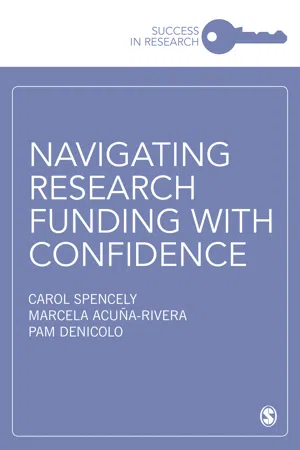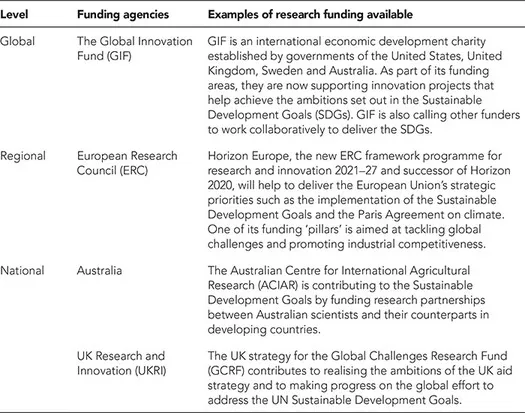Introduction
Navigating the world of research can be a highly rewarding experience but, to benefit from the range of research funding opportunities available, you need to understand its wider context. Research does not happen in isolation and funding agencies usually allocate funds based on global, regional, national, institutional or more local drivers including their own priorities. Even though global challenges may influence lower-level priorities, each region or country will also want to address their specific needs and may allocate more funds to research projects that meet their own aims.
Understanding the influence that the key drivers of research have in setting up the global or national agendas is critical because it will help you identify the topics and challenges that, for instance, your government and other funding agencies are more interested in and thus where they may direct more financial support. For example, the United Nations (UN) have recognised that poverty, food security, clean water and good health are among the most important challenges of our era and that all countries should contribute to their solution. As a result, several countries have included these challenges as part of their national funding agenda.
This chapter aims to help you to consider the wider context when planning your research and to reflect on how you can help with tackling these challenges. Different countries may seek different research outcomes and it will be important that you identify what matters to your research funder (whether national or international), your institution and your country. In doing so, you will also increase your chances of success in securing research funding.
The global challenges
Different world organisations, such as the United Nations, set their priorities based on global challenges and they urge all member countries to embrace these and work more collaboratively when implementing their national plans. One way of implementing their plans to address their strategic priorities is through the allocation of financial support aimed at funding research that helps to tackle such challenges. As a result, major national and international funding agencies are going through a period of rapid change where local and global needs influence a large proportion of their funding priorities.
One of the most influential world agreements is the 2030 Agenda for Sustainable Development, adopted by all United Nations Member States in 2015 (Paris), which provides a framework for peace and prosperity for people and the planet, now and into the future. In their agenda, there are 17 Sustainable Development Goals (SDGs) which are an urgent call for action to tackle poverty, inequality, climate change, environmental degradation, food security, peace, justice and other global problems. To achieve this, all member countries should develop strategies that ‘improve health and education, reduce inequality, and spur economic growth – all while tackling climate change and working to preserve our oceans and forests’.
In response, several countries have implemented a number of actions that contribute to the aims of this agenda, including the allocation of more funding to research areas directly associated to the 17 goals stated in the 2030 agenda. This means that, besides supporting their national priority areas, they will also provide funding to research aimed at achieving the global SDGs. Information Box 1.1 includes some examples of how these global challenges have influenced regional and national research priorities.
Information Box 1.1 Sustainable Development Goals (UN, 2015) and its impact on funders’ funding priorities
Another global challenge (and an opportunity for researchers) that is influencing the research agenda in many countries is that associated with population ageing and its implications for health and wellbeing. Although our understanding of population ageing is most advanced in developed countries, particularly in Europe and Northern America, two-thirds of the world’s older persons live in developing regions and the proportion is growing fast. In 2050, older persons are expected to account for 35% of the population in Europe, 28% in Northern America, 25% in Latin America and the Caribbean, 24% in Asia, 23% in Oceania and 9% in Africa (UN, 2017).
World organisations such as the United Nations (UN) and the World Health Organization (WHO) have put plans and programmes in place to increase our understanding of the implications of an ageing population and how to help people to live better. Consequently, governments and other agencies are directing more funds to support research into these areas such as through UK Research and Innovation (UKRI), the European Research Council (ERC) (via H2020 and the forthcoming Horizon Europe programmes) and the National Institutes of Health (NIH) in the USA. The Velux Stiftung (a research foundation in Switzerland) adopted some of the priorities set up by WHO regarding healthy ageing and is directing more funds to support basic or applied research on healthy ageing in several fields such as biology, medicine, psychology and neurosciences.
The digital transformation of societies, artificial intelligence (AI) and the internet of things (IoT) are other very important research priorities of our time. Modern societies are practically surrounded by electronic systems, devices and resources that generate or process big data such as social media, mobile phones and online games. Despite the accelerated progress in these areas, more research investigating other innovative uses and potential impacts is needed. Governments, funders and industry are increasing their financial support to research that generates or uses large bodies of data in order to inform policy development and effective interventions in areas such as medicine, healthcare, climate change, energy, agriculture, education and robotics, to name a few. For example, the Social Sciences and Humanities Research Council in Canada has among its six challenge areas to explore and understand better the complexities of the digital age including its societal, environmental and economic impact. Similarly, more research investigating current and new AI applications in different areas such as medical diagnostics and remote sensing are needed.
Finally, research investigating the presence of plastics in the environment (e.g. oceans, soil and air) and the food chain (e.g. animals, plants) is growing and rapidly becoming an emerging priority. Governments and research funders from several countries are directing financial support towards zero plastic waste (UK) and other areas such as higher quality plastics, effective recycling, food packaging and micro-plastics.
The challenges and examples presented in this section are not intended to be exhaustive but to illustrate how some countries or regions have responded to global agendas in addition to their own research priorities. There are funders who, as part of their remit, have already been supporting research in these areas and their efforts will create synergy with other agencies and stakeholders who are funding research to tackle the global challenges.
We recommend that you conduct a search to identify the specific research priorities and associated funding opportunities in your own country; these are usually included in your government’s delivery plan or in their research funding allocation. You can also look at national and international funders’ delivery plans or strategies to find out what challenges they are interested in and the type of research they are more interested in funding. See Reflection Point 1.1 for an exercise that may help you shape these agendas as an expert in your discipline.
Reflection Point 1.1 How you can influence the research funding agenda
You can influence the national and international governmental or funding research agendas by:
- Responding to research funding or strategic consultations that are relevant to your field. In doing so, you will learn what these decision-makers are interested in and your views will help them to shape new funding programmes and opportunities. They certainly want to hear from you as an expert in the area.
- Participating as a reviewer or as a member of relevant funding committees. This will help you understand them better and to influence their priorities and requirements. Usually, funders open public calls to invite researchers and other stakeholders to take part in their Peer Review College or panels. Make the most of these opportunities and you will also increase your chances of success when seeking funding for your research.
Considering these points, reflect on what steps you could take to influence the research agenda.
Research impact
Some funders only have one criterion for assessment, which is excellent research that enhances our understanding of the world, whereas others also give weighting in their decision to the demonstrable impact that research makes to society and economic growth. This is called research impact and some funders require applicants to clearly state what the potential impact of their research will be and how they will achieve it (pathways to impact) as part of their application. Information Box 1.2 shows the three types of impact that have traditionally been recognised by research funders.
Information Box 1.2 Research impact
Based on the literature, we have identified some principles that are central to impact:
- Public engagement is crucial to achieve impact. This is a two-way process where researchers and communities talk to each other to enhance research, promote learning and develop further skills.
- You can enhance the quality of your research and generate impact by engaging with the potential beneficiaries and users of your research at the early stages of the proposal to develop it jointly. This is called co-creation of research.
- Multidisciplinary collaboration between different sectors brings the best outcome and it also maximises the impact of your research.
- Being aware of the wider context helps you consider more innovative approaches to your research and how it can be used by the wider community.
- Effective knowledge exchange between researchers, potential beneficiaries, industry and the public sector is key to generating impact and innovation. This means that the outcomes of your research should be translated into clear actions or guidelines that can be applied by policy-makers, industry and other relevant stakeholders such as the government.
Being aware of the potential impact of your research is good practice and, although not all funders include a specific section in their application forms, they will want to see how your research will make a difference to society or the specific groups they target when funding research. Please see Voice of Experience 1.1 for an example of this.
Voice of Experience 1.1 Professor Monique Raats gives an example about impact in her research field
Nutrition labelling helps consumers to make informed food choices. The Food, Consumer Behaviour and Health Research Centre (FCBH) has conducted a number of studies on how people make use of and understand the labels on food products. These studies have been used by UK and EU regulators in forming labelling policies and constructing food information regulations. FCBH research developed a typology that helps to understand the difference between different labelling systems used around the world (Hodgkins et al., 2012), grouping them according to directiveness, i.e. the extent to which the labels provide explicit advice about product healthfulness.
In May 2012 the four UK governments launched a joint food labelling consultation. One of the questions put to consultees resulted from FCBH’s findings (Hodgkins et al., 2012). By October 2012, Anna Soubry (Health Minister) announced that the UK Government would work towards a consistent Front of Pack (FOP) scheme based on a hybrid approach of % Guideline Daily Amounts (GDA) and traffic light colour coding. This is in line with the findings of the FCBH research (Malam et al., 2009; Hodgkins et al., 2012). This approach gained the support of all the leading retailers in the UK, many of whom were previously resistant to harmonization. Technical guidance for implementation of the new hybrid label was issued in June 2013. This technical guidance cited FCBH research that showed that market penetration (e.g. see Storcksdieck et al., 2010) is key to consumers noticing and becoming familiar with labelling information.
Governments and industry promote nutrition ...


